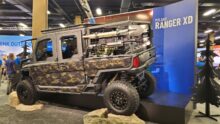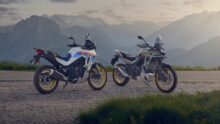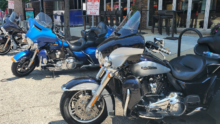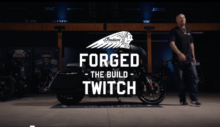Bell focuses on safety at all speeds
Company leans heavily on R&D while also improving dealer relations
With a thud, a Bell Moto-9 dropped from more than 10 feet in the air onto a metal base. Everyone in the room knew it was coming, but the sound still drew a cringe from many as a Bell test lab engineer demonstrated one of the many tests that the company’s helmets are subjected to before landing on dealers’ shelves.
Bell recently hosted a variety of industry media at its Scotts Valley, Calif., facility affectionately known as The Dome. In addition to executive offices and colorful displays of Bell products across all of Easton-Bell’s lines, The Dome houses an impressive R&D facility, complete with three linear impact machines, two rotational impact rigs, a high-speed camera, vacuum-form machines, an injection molder, a variety of 3-D printers, a woodshop, a metal shop, a paint shop, a miniature wind tunnel, the Advanced Concepts department and more.
Intensive R&D
The testing demonstration and visits to other areas of The Dome were part of an effort for Bell to once again start talking about safety and the R&D that goes into developing helmets that are focused on safety first.
Since the early 1990s, helmet companies have kept relatively quiet about safety. In the ’90s, the U.S. became particularity litigious, with many bringing lawsuits against any helmet company that claimed to be the “safest” or “safer” than any other brand. Those suits — even the ones that resulted in the helmet companies’ favor — hit the industry hard, as each brand had to spend massive amounts of money on lawyers, court costs and more.
But now Bell and other helmet companies are again beginning to talk about the efforts they go through to make sure the helmets they develop are going to be able to protect riders in a variety of crashes. Though its still shying away from the “-er” and “-est” qualifiers, Bell is sharing more about its testing, which puts every helmet through intense rigors during development and as each batch of each style comes out of the factory.
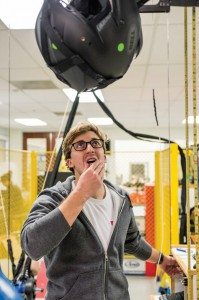
“Comprehensive testing has been the Bell standard for 60 years, ever since we developed the first helmet. [Bell founder] Roy Richter, his goal was to save his friends’ lives, so they could keep [auto] racing, and it was to make sure that they could get into the car after a wreck,” said Chris Sackett, business unit director.
Bell tests its helmets for crashes at all speeds and at a variety of angles, so it can be confident in the product it puts to market.
“It’s not just testing for catastrophic injuries or catastrophic crashes — it’s testing across the board, whether it’s a low-speed tip over, a mid-speed … off a little double, or actually a 100-mile-an-hour crash out in the desert,” Sackett said.
Bell engineers its helmets in-house and tests them throughout the development process, from prototype to finish product from the factory. Tests not only assure Bell will meet, but rather exceed, industry certification standards.
“There are some standards out there that will tell you where they’re going to hit the helmet when they test the helmet, and so there are definitely companies that are out there manufacturing helmets to pass these various spots. But we’re actually out there probing the helmet,” Sackett said. “We’re designing the helmet and hitting it in every possible location we possibly can to make sure that it’s protecting you across the board in all locations. That’s a big difference between us and our competition.”
Depending on distribution and use, Bell strives to reach different standards. In the U.S., it adheres Department of Transportation certification, and in Europe and other nations, it abides by ECE standards developed by the United Nations Economic Commission for Europe. A number of helmets also achieve Snell approval by the Snell Memorial Foundation. Each standard is different, requiring impacts at different speeds, each in unique places and requiring slightly different dummy head sizes.
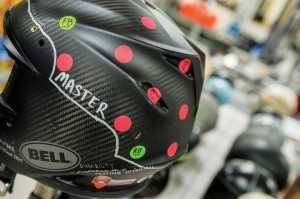
Snell is the most stringent, being able to hit any point above a certain line of a helmet, with a 7.75 meters/second (about 17 mph) impact followed by a 6.6 meters/second (nearly 15 mph) hit in the same place. With those two hits, the peak acceleration cannot surpass 275 Gs. But Bell doesn’t strive to just squeeze by those requirements; instead, engineers test helmets with the goal of failing them, so they can continue to improve them until they exceed the certification limits.
“We’re not just focusing on beating the standard by 10 Gs. We’re actually looking to massively exceed the standard and test throughout the whole possible range of impact scenarios,” Sackett said. “We’re producing helmets that are going to protect best throughout all the different types of impacts you might see.”
Tests completed by Bell engineers include the standard linear impact tests, which involve dropping a helmet from at a specified velocity onto a certain shape (flat, curved and edge surfaces are tested); chinbar tests, which apply pressure to the chinbar to assure it won’t buckle under certain impacts; and penetration tests, which involve dropping a 5 kg mass onto the helmet to simulate a direct impact. Bell has also begun studying rotational impact.
Though some standards, such as ECE, specify where they will strike a helmet, Bell “peppers” all of its lids in various places, so they don’t fail in areas typically not tested.
After Bell has completed its tests, helmets are sent to a third-party lab for verification. Though that step isn’t required per Department of Transportation regulations, it’s just one of the ways in which Bell goes above and beyond in assuring each helmet’s integrity.
“The reality of our sport — nobody knows how they’re going to crash,” Sackett said. “We’ve always said if you knew how you were going to crash, we would build you the perfect helmet. Our goal now is to build you a helmet that’s going to cover you in all aspects the best we possibly can.”
Renewed dealer focus
While Bell has always focused on R&D, the company will admit that its dealer relations weren’t up to par a few years ago. Easton-Bell Sports, Inc., which also produces bicycle, hockey, lacrosse, football and auto racing helmets, was running its powersports division similar to how it operates its bicycle business, with little differentiation between the two. In reality, the industries are unique.
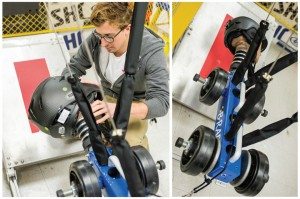
Bell realized its mistake in 2011, and vast improvements have been made since. Dealer programs, customer service, communication, products and pricing all were improved in an effort to better serve powersports dealers and customers. And dealers have noticed. Since the change, Bell has tripled its dealer count, and the company’s powersports division has grown sevenfold.
“It’s honestly going gangbusters,” Sackett told Powersports Business.
The powersports segment now has more resources, and more money has been invested in personnel for customer service and other areas. Bell also is focusing more on educating dealers and consumers about its powersports helmets.
“Ultimately we want our dealers to be really successful with our brand,” Sackett said.
He added, “There’s no hiding the fact that we want to be the No. 1 helmet brand again.”
On the powersports side, Bell makes helmets for motocross, road racing, scooter and cruiser riders, and it recognizes that each segment is different, requiring a unique variety of products and education.
“In the cruiser segment, our goal is to actually get people in helmets, so the goal is a little bit different than it is with motocross, where … in motocross everyone wants to wear the safest helmet — it’s a total different thing,” Sackett said. “In cruisers, they don’t really want to wear helmets, so if you’ve seen some of the products that we’ve come out with the last couple years like the Rogue, our goal is to basically get the guy who’s not going to wear a helmet into a helmet. And once he’s wearing a helmet, we transfer that guy into a full-face helmet, and then when he’s wearing a full-face helmet, we transfer him into a helmet that maybe has something more performance-driven.”
For that reason, Bell also makes helmets available at a variety of price points, and though some are inexpensive when compared to others, each still adheres to Bell’s strict safety standards.
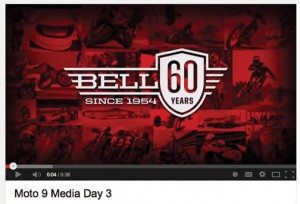
To watch some of Bell’s comprehensive
testing and see more of Bell’s Media Day, check out this story in the digital edition of Powersports Business, or visit this link: http://bit.ly/1c9fprf.
“Yes, there are brands that make inexpensive helmets that probably aren’t going through the rigorous testing that we are; we’re confident that there’s a lot of them, actually, but there are a lot of companies that are doing exactly what we’re doing here — all the development, all the testing on our inexpensive helmets. They’re just inexpensive because we use materials that are a little bit heavier and maybe don’t have as many vents, or the lining or the shield is maybe not as expensive,” Sackett said.
Since his father-in-law and three friends died in motorcycle crashes, Sackett has become especially involved with efforts to get more riders to willingly wear helmets.
“It’s kind of a personal vendetta to make sure we’re protecting motorcyclists as much as we can, so the sport doesn’t dwindle,” he said.
Sackett said though he and Bell don’t believe in mandatory helmet laws, they do have hopes for getting more riders protected, and that goal isn’t just based on trying to make money, but instead, growing the sport.
“We reinvest a massive amount of our profit into developing our product,” he said.
And from all the testing that’s done, it’s clear that development is geared heavily toward safety.
“There are helmet companies, a couple of them. Arai and Shoei are helmet companies — they make helmets. They’ve tested them. They do a good job making helmets, and there are others, too, not to name them all,” Sackett said. “We are a helmet company. There are plenty of companies making helmets, as you know, they’re a marketing company, and a helmet is an extension of their product line. Some of them do a good job; some of them are just sourcing helmets off the shelf of manufacturers and putting their name on it, so there is a difference. We focus on head protection; Shoei [and] Arai focus on head protection. I think it’s just important to note that those are the differences.”

